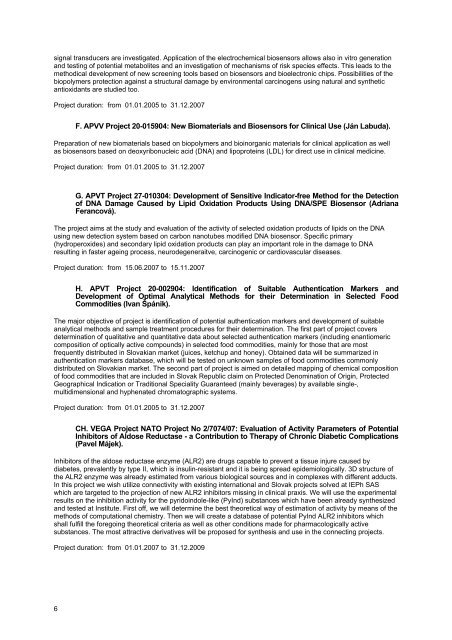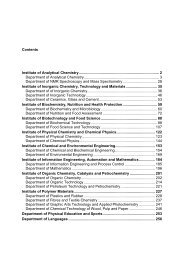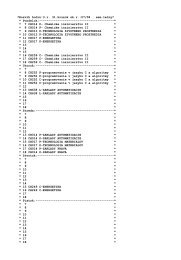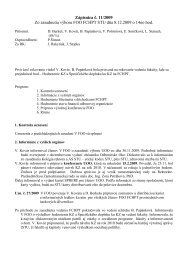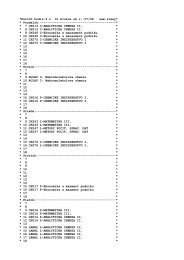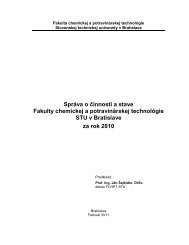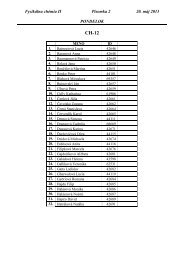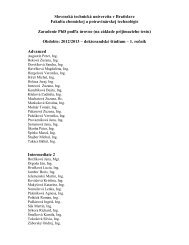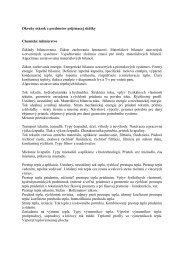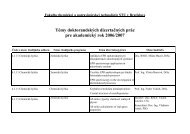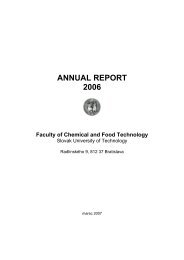rok 2007 - Fakulta chemickej a potravinárskej technológie
rok 2007 - Fakulta chemickej a potravinárskej technológie
rok 2007 - Fakulta chemickej a potravinárskej technológie
You also want an ePaper? Increase the reach of your titles
YUMPU automatically turns print PDFs into web optimized ePapers that Google loves.
signal transducers are investigated. Application of the electrochemical biosensors allows also in vitro generation<br />
and testing of potential metabolites and an investigation of mechanisms of risk species effects. This leads to the<br />
methodical development of new screening tools based on biosensors and bioelectronic chips. Possibilities of the<br />
biopolymers protection against a structural damage by environmental carcinogens using natural and synthetic<br />
antioxidants are studied too.<br />
Project duration: from 01.01.2005 to 31.12.<strong>2007</strong><br />
F. APVV Project 20-015904: New Biomaterials and Biosensors for Clinical Use (Ján Labuda).<br />
Preparation of new biomaterials based on biopolymers and bioinorganic materials for clinical application as well<br />
as biosensors based on deoxyribonucleic acid (DNA) and lipoproteins (LDL) for direct use in clinical medicine.<br />
Project duration: from 01.01.2005 to 31.12.<strong>2007</strong><br />
G. APVT Project 27-010304: Development of Sensitive Indicator-free Method for the Detection<br />
of DNA Damage Caused by Lipid Oxidation Products Using DNA/SPE Biosensor (Adriana<br />
Ferancová).<br />
The project aims at the study and evaluation of the activity of selected oxidation products of lipids on the DNA<br />
using new detection system based on carbon nanotubes modified DNA biosensor. Specific primary<br />
(hydroperoxides) and secondary lipid oxidation products can play an important role in the damage to DNA<br />
resulting in faster ageing process, neurodegeneraitve, carcinogenic or cardiovascular diseases.<br />
Project duration: from 15.06.<strong>2007</strong> to 15.11.<strong>2007</strong><br />
H. APVT Project 20-002904: Identification of Suitable Authentication Markers and<br />
Development of Optimal Analytical Methods for their Determination in Selected Food<br />
Commodities (Ivan Špánik).<br />
The major objective of project is identification of potential authentication markers and development of suitable<br />
analytical methods and sample treatment procedures for their determination. The first part of project covers<br />
determination of qualitative and quantitative data about selected authentication markers (including enantiomeric<br />
composition of optically active compounds) in selected food commodities, mainly for those that are most<br />
frequently distributed in Slovakian market (juices, ketchup and honey). Obtained data will be summarized in<br />
authentication markers database, which will be tested on unknown samples of food commodities commonly<br />
distributed on Slovakian market. The second part of project is aimed on detailed mapping of chemical composition<br />
of food commodities that are included in Slovak Republic claim on Protected Denomination of Origin, Protected<br />
Geographical Indication or Traditional Speciality Guaranteed (mainly beverages) by available single-,<br />
multidimensional and hyphenated chromatographic systems.<br />
Project duration: from 01.01.2005 to 31.12.<strong>2007</strong><br />
CH. VEGA Project NATO Project No 2/7074/07: Evaluation of Activity Parameters of Potential<br />
Inhibitors of Aldose Reductase - a Contribution to Therapy of Chronic Diabetic Complications<br />
(Pavel Májek).<br />
Inhibitors of the aldose reductase enzyme (ALR2) are drugs capable to prevent a tissue injure caused by<br />
diabetes, prevalently by type II, which is insulin-resistant and it is being spread epidemiologically. 3D structure of<br />
the ALR2 enzyme was already estimated from various biological sources and in complexes with different adducts.<br />
In this project we wish utilize connectivity with existing international and Slovak projects solved at IEPh SAS<br />
which are targeted to the projection of new ALR2 inhibitors missing in clinical praxis. We will use the experimental<br />
results on the inhibition activity for the pyridoindole-like (PyInd) substances which have been already synthesized<br />
and tested at Institute. First off, we will determine the best theoretical way of estimation of activity by means of the<br />
methods of computational chemistry. Then we will create a database of potential PyInd ALR2 inhibitors which<br />
shall fulfill the foregoing theoretical criteria as well as other conditions made for pharmacologically active<br />
substances. The most attractive derivatives will be proposed for synthesis and use in the connecting projects.<br />
Project duration: from 01.01.<strong>2007</strong> to 31.12.2009<br />
6


